Have you noticed that software development borrows a lot of its terminology from construction? Like construction projects, software development often follows a phased approach with distinct stages such as design, development, and maintenance mirroring the construction process.
And just as construction architects adhere to principles of structural integrity, aesthetics, and functionality, solution architects follow design principles to ensure that their products are robust, efficient, and aligned with business goals.
Now let's address these questions: What is solution architecture, what processes does it entail, and how do you know that you need it for your project?
What is solution architecture?
Solution architecture (SA) is the practice of designing comprehensive solutions to address specific business problems or fulfill particular business needs. It involves creating a blueprint or plan for integrating various components such as software, hardware, networks, processes, and services, into a cohesive and effective system.
For example, a retail company faces the challenge of integrating its online and offline sales channels to provide a seamless omnichannel shopping experience for customers. Solution architecture can help address this business problem by designing a comprehensive solution that connects various components such as eCommerce platforms, point-of-sale systems, inventory management systems, customer relationship management software, and logistics systems.
Or consider a financial institution that wants to better protect its customers' accounts and transactions. Solution architecture can help address this business problem by designing a comprehensive fraud detection system.
The person in charge of designing a technical vision for a solution is called a solution architect.
Solution architects typically have a deep understanding of various technologies, systems, and processes relevant to their domain, such as software development, cloud computing, business analysis and project management. They often work closely with stakeholders from different departments, including business leaders, IT professionals, project managers, and end users to gather requirements, understand challenges, and ensure that the proposed solution meets the needs of all parties involved.
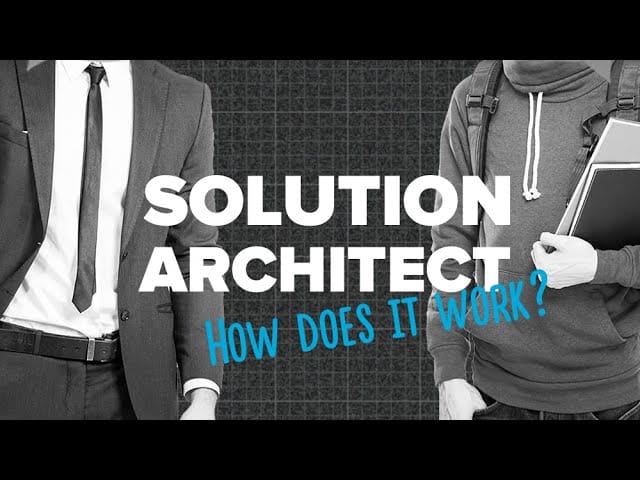

It’s important to make a distinction between solution architecture and other similar disciplines in software development as they are different in scope, focus, and objectives.
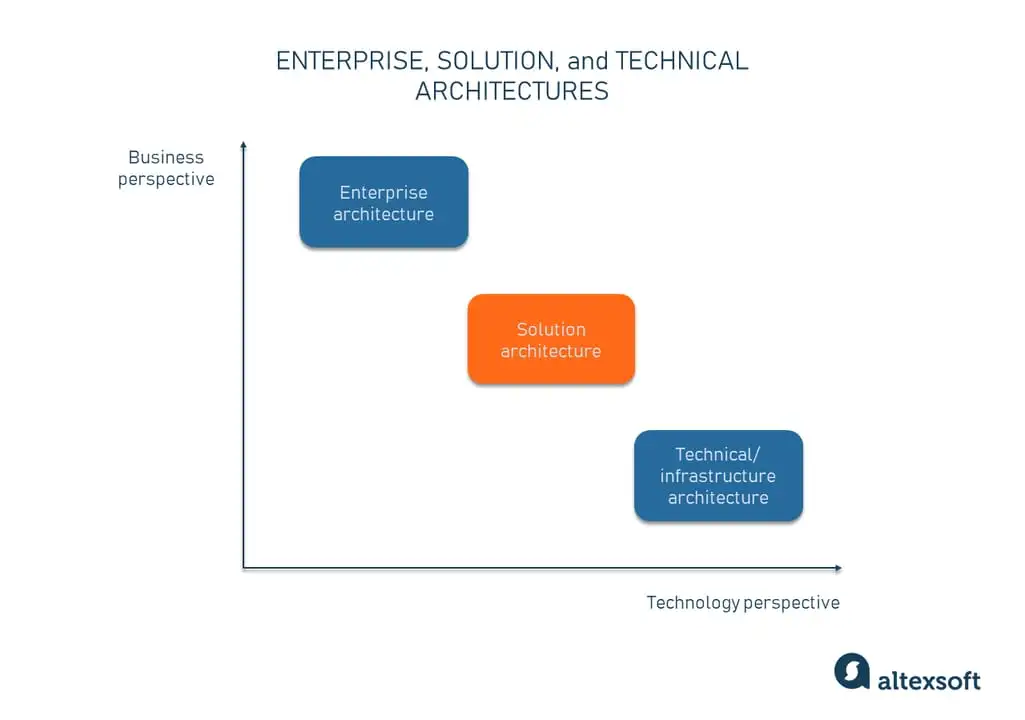
Visualizing the difference between levels of architecture
Solution architecture vs enterprise architecture
Enterprise architecture provides a holistic and strategic view, concentrating on an organization's complete structure, operations, and systems.
It encompasses analyzing and designing various aspects such as business architecture, information architecture, application architecture, and technology architecture to ensure coherence with business objectives.
The main difference with SA is that enterprise architects formulate long-term strategies and plans for technology investments, integration, standardization, and governance throughout the organization.
Basically, where solution architecture is occupied with finding a technical approach to solving business problems, enterprise architecture tries to align technology solutions with the overall business strategy, enhancing interoperability and optimizing resource allocation.
Solution architecture vs technical architecture
Technical architecture, on the other hand, focuses specifically on the design and implementation of the technical components within a system.
It deals with the detailed specifications, configurations, and interactions of hardware, software, networks, databases, and other technical elements.
Technical architects are responsible for selecting appropriate technologies, defining system interfaces, designing data models, and ensuring the technical feasibility and performance of the solution.
So while solution architecture addresses how technology can be used to address business needs, technical architecture addresses detailed specifications of a solution, such as system performance, scalability, security, reliability, and maintainability.
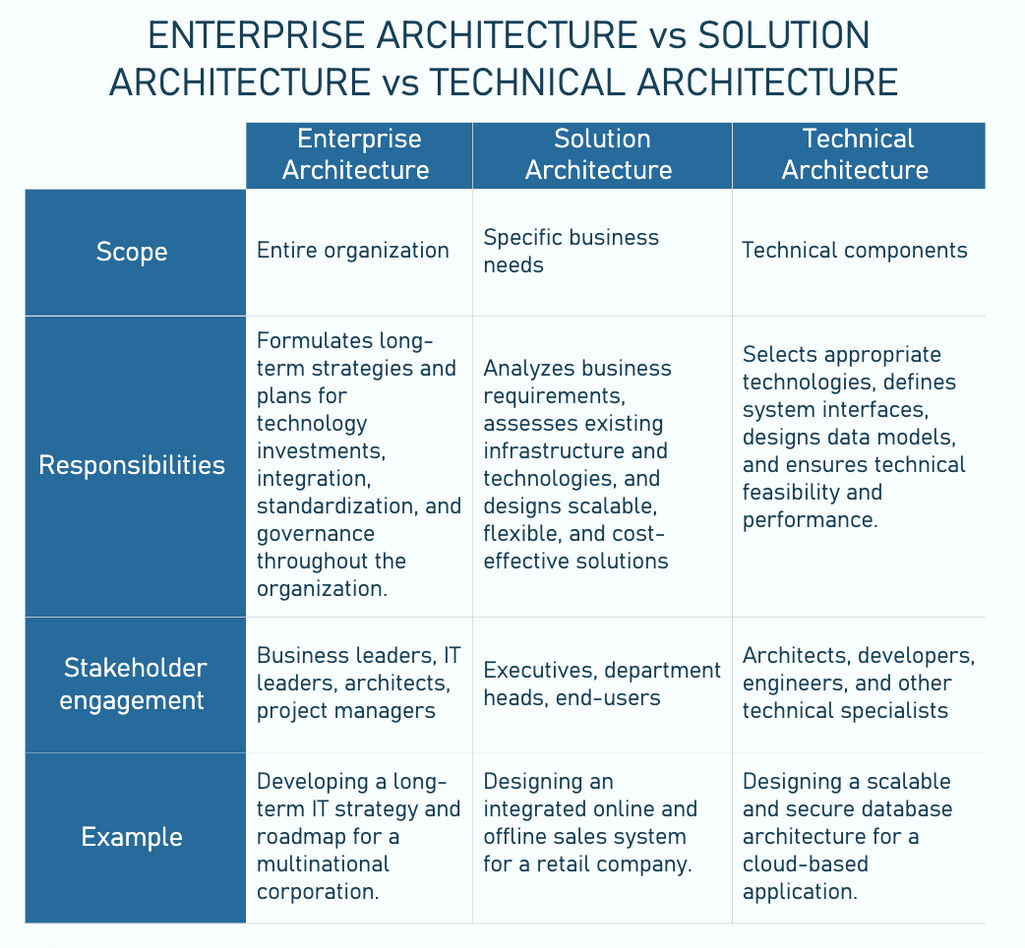
Comparing different architecture types in software development
Solution architecture process
The solution architecture process involves several key steps that guide the design and implementation of a comprehensive solution to address specific business needs or problems within an organization. While the details may vary depending on the context and requirements of the project, the general solution architecture process typically includes the following stages.
1. Understanding business requirements
Before a solution architect starts designing the architecture, the organization's needs and objectives must be addressed. To do this, the following activities will be performed.
Identifying stakeholders. This includes engaging with key stakeholders who will be impacted by or have a vested interest in the solution. These stakeholders may include executives, department heads, end-users, IT professionals, customers, and external partners.
Gathering requirements. Here you conduct interviews, workshops, or surveys with stakeholders to gather comprehensive requirements for the solution. At this point, you start understanding the business goals, objectives, challenges, opportunities, and constraints that the solution needs to address.
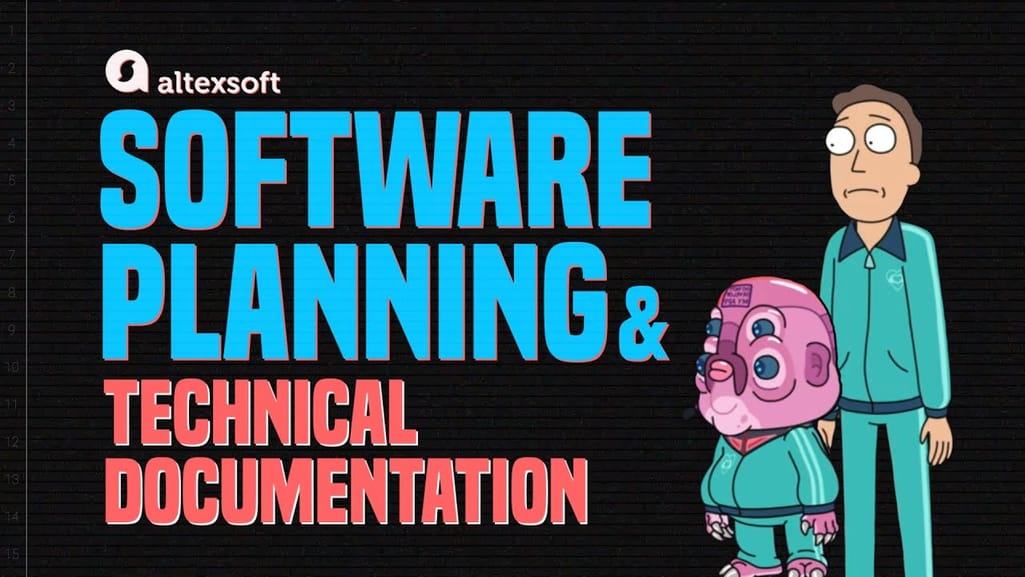

Learn more about preparing software requirements in our video
Analyzing and documenting requirements. A solution architect sifts through requirements to identify the most critical and relevant aspects that should drive the design of the solution. This may involve categorizing requirements into functional and non-functional groups. In software development, requirements are typically documented in a specific manner, such as with user stories or use cases. They are normally compiled in a software requirement specification (SRS) document.
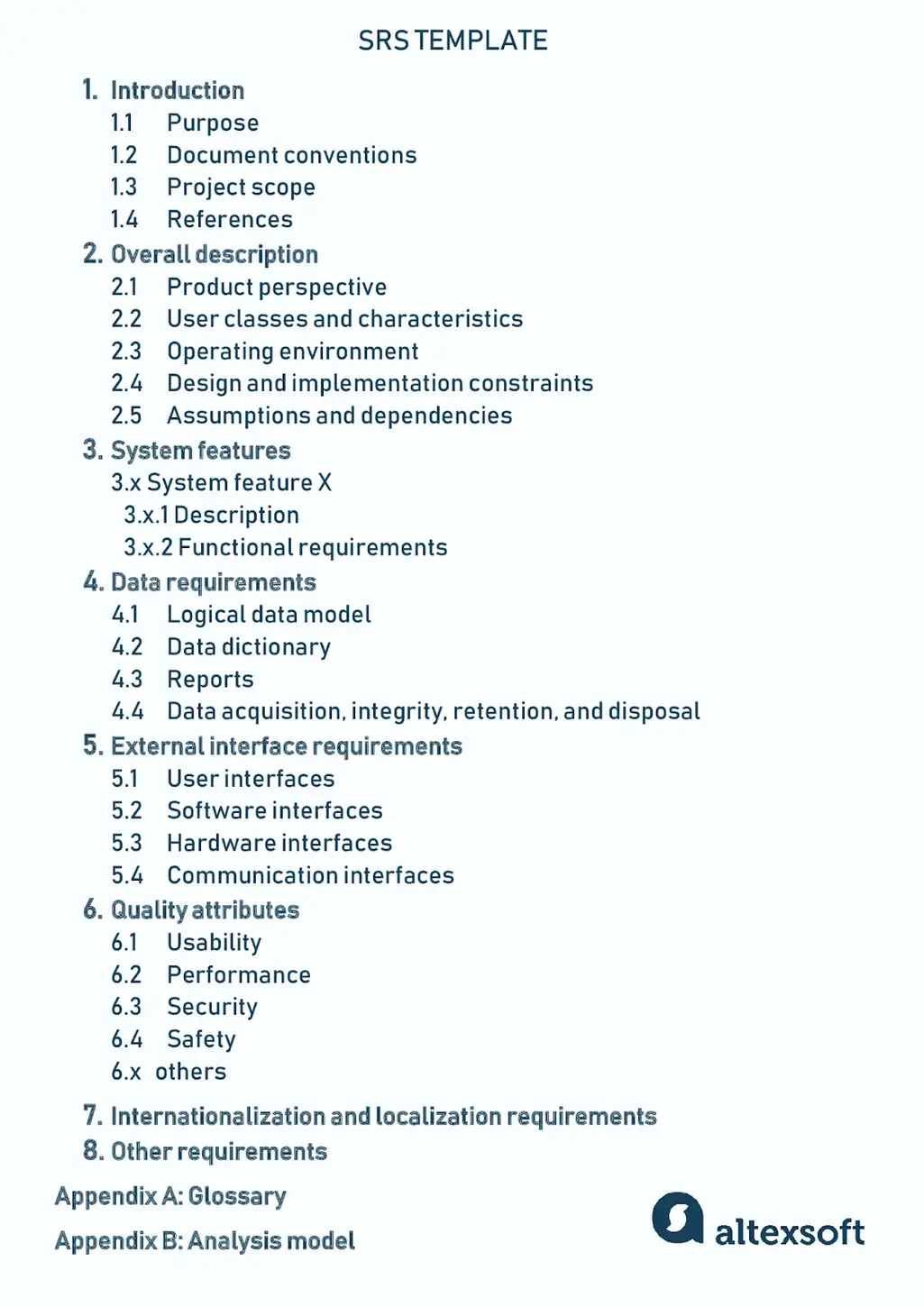
A template for a software requirements specification
2. Evaluating the current state
By gaining a thorough understanding of the business requirements and assessing the current state of the organization, solution architects can lay a solid foundation for designing and implementing a solution that meets the organization's objectives and aligns with its capabilities and constraints. This stage includes such processes as:
Evaluating existing infrastructure. This means assessing the organization's current IT infrastructure, including hardware, software, networks, and data centers, as well as the performance, reliability, scalability, and security of existing systems and technologies.


Analyzing business systems and processes. A software architect will analyze existing business systems, applications, and processes to understand their architecture, functionality, and integration points. Also identified will be any bottlenecks, inefficiencies, or gaps in the current systems that need to be addressed by the new solution.
Assessing the technology landscape. Now a software architect evaluates opportunities to leverage new technologies or modernize existing systems to enhance the organization's capabilities.
Considering organizational readiness. Finally, it’s important to assess the organization's readiness and capacity to adopt and implement new solutions, including factors such as culture, skills, resources, and change management capabilities. Besides, there may be potential barriers or challenges that may hinder the successful adoption of the solution.
3. Defining solution vision and solution architecture diagram
At this stage, a solution architect is ready to document and present the components of the future solution. This includes the following processes.
Establishing solution goals and objectives. A solution architect will define specific, measurable goals the solution aims to accomplish that should be aligned with the organization's strategic objectives and business priorities. They also offer qualitative and quantitative metrics to measure the success of the solution, such as increased efficiency, improved customer satisfaction, cost savings, or revenue growth.
Defining solution features. A solution architect will now identify the key functionalities, features, and capabilities that the solution will provide to address the identified business requirements and user needs.
Documenting a Solution Concept Diagram. Using visual aids such as diagrams, charts, and mockups, a solution architect will illustrate the solution vision and scope and make it easier for stakeholders to understand. A typical representation of a solution vision is created with a solution concept diagram – the high-level technical view of the architecture.
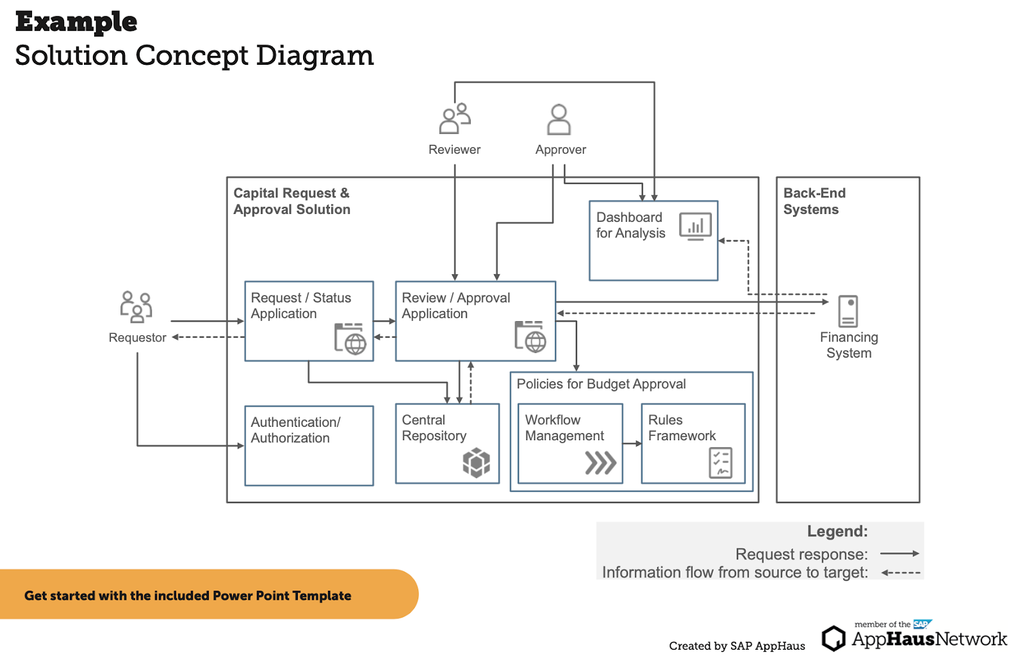
Example of a Solution Concept Diagram. Source: SAP AppHaus
Copyright © 2024 SAP SE or an SAP affiliate company. All rights reserved
4. Creating solution design
Finally, a solution architect lays the foundation of the solution design and implementation with the following processes.
Identifying major components. A conceptual architecture is created at this point with major subsystems, modules, and layers, including their relationships and dependencies.
Choosing technologies. A solution architect identifies technologies and platforms to realize the solution. Considering factors such as functionality, scalability, interoperability, and maintainability, frameworks, libraries, and tools will be chosen that can support the solution requirements.
Defining interactions. This includes establishing the interfaces and interactions between different components and subsystems of the solution, for example, specifying how data will flow between modules, as well as the protocols, formats, and APIs used for communication.
Refining the high-level design. After gathering feedback from stakeholders and subject matter experts, solution architects identify any gaps or areas for improvement, iterating on the design as needed.
Defining standards and guidelines. Finally, the design is translated into detailed specifications, including data models, system architectures, component interfaces, and integration points. This also includes technical requirements, standards, and guidelines that will govern the implementation of the solution.
5. Prototyping and testing technical feasibility
Prototyping is a crucial step in the solution architecture process as it’s used to validate key design decisions and assumptions, such as user interface design, data model design, system architecture, or technology stack.
A prototype or a proof of concept is often created at this stage. It doesn’t have to represent the whole solution but can simply explore specific aspects of the solution architecture. Prototypes may range from simple mockups or wireframes to functional prototypes that test the technical feasibility of the system. Its main goal is to measure and analyze the performance, scalability, reliability, and security of the solution to identify any technical challenges or limitations.

Feasibility analysis is an iterative process
A solution architect is one of the main team members involved in checking technical feasibility, which studies such aspects of the project as:
- hardware and software components,
- technical risks and constraints,
- compatibility with other IT systems, and
- capabilities of your engineering team.
Using iterative development, prototyping, and feedback loop, the technical design of the solution is refined until a solution architect decides what tools you must acquire or build, what implementation scenarios would be most efficient, or whether you will need any customizations.
6. Finalizing solution architecture and implementing it
In the end, it’s a solution architect’s job to work closely with development teams to ensure that they understand the design specifications and requirements outlined in the solution architecture documentation. This includes the following processes.
Collaborating with dev teams. They follow the development by providing guidance, clarification, and support to teams as they translate the architecture into working code, ensuring that they adhere to the design principles and standards.
Addressing implementation challenges. Whenever implementation challenges arise, a solution architect proactively identifies them and works with stakeholders and technical teams to address them in a timely manner, providing guidance, troubleshooting assistance, and problem-solving support as needed.
Ensuring quality. Finally, a solution architect ensures that the implemented solution adheres to the design specifications, quality standards, and compliance requirements by conducting reviews, inspections, and tests to verify that the implemented solution meets the expected functionality, performance, security, and reliability criteria.
Solution architecture frameworks: TOGAF, Zachman, ArchiMate
Solution architecture is a complex process, so it makes sense that the practice often relies on time-tested methodologies to design and implement architectures. Such frameworks provide structured approaches and best practices for managing complex solutions within organizations, and here we will cover four of the most popular ones.
Although some of these frameworks are also used in enterprise architecture, they can be beneficial to solution architects as well. All of them have been standardized by The Open Group –- a global consortium focused on developing open technology standards.
TOGAF (The Open Group Architecture Framework)
TOGAF was derived from the Technical Architecture Framework for Information Management (TAFIM), developed by the US Department of Defense in the 1990s. TAFIM aimed to standardize and improve the management of information technology within the military.
Since its initial release, TOGAF has undergone several updates and revisions to incorporate new concepts, methodologies, and best practices.
At the core of the TOGAF methodology is the Architecture Development Method (ADM).
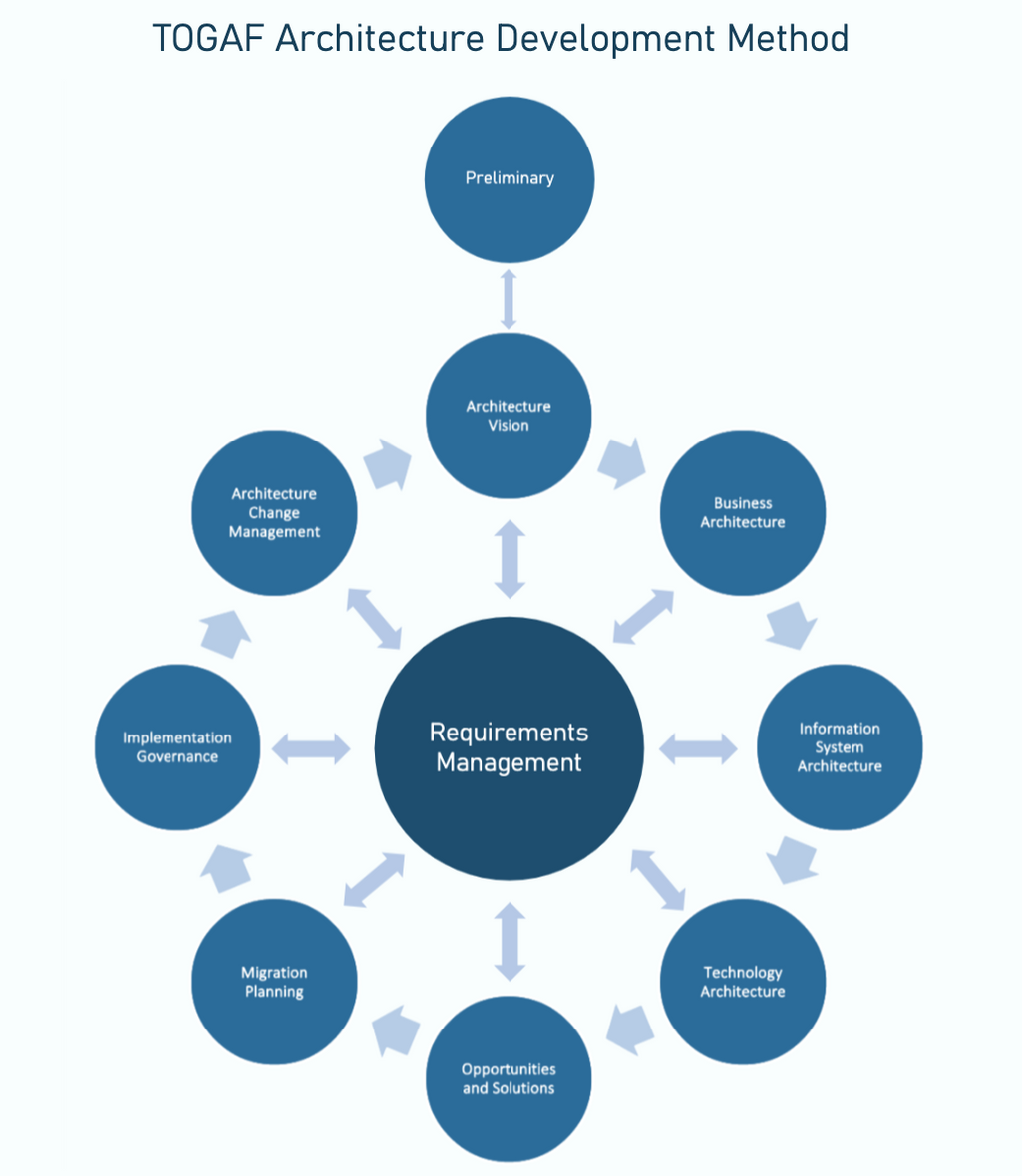
TOGAF Architecture Development Method
The ADM consists of a series of iterative phases, each focusing on specific aspects of the architecture development process. These phases provide a structured framework for progressing from initial concept to final implementation. The phases include:
Preliminary Phase. Establishes the architecture framework and principles, and prepares the organization for architecture development.
Phase A: Architecture Vision. Defines the initial scope, stakeholders, business goals, and high-level requirements of the architecture.
Phase B: Business Architecture. Develops a detailed understanding of the organization's business processes, functions, capabilities, and organizational structure.
Phase C: Information Systems Architecture. Defines the information systems architecture, including data architecture, application architecture, and technology architecture.
Phase D: Technology Architecture. Specifies the technology infrastructure and platforms required to support the implementation of the architecture.
Phase E: Opportunities and Solutions. Identifies and evaluates potential solutions, alternatives, and implementation approaches.
Phase F: Migration Planning. Develops a detailed migration plan for transitioning from the current state to the target architecture.
Phase G: Implementation Governance. Establishes governance mechanisms and processes to oversee the implementation of the architecture.
Phase H: Architecture Change Management. Manages changes to the architecture throughout its lifecycle, ensuring alignment with business goals and objectives.
Requirements Management Phase. Manages and prioritizes architecture requirements, ensuring that they are captured, documented, and addressed appropriately.
The ADM provides a structured and systematic approach to architecture development, guiding architects through the process from start to finish.
The Zachman Framework
The Zachman Framework was developed by John Zachman in the 1980s while he was working at IBM. It emerged from his observations of how organizations struggle to manage and understand the complexities of their information systems. Over the years, Zachman continued to refine and develop the framework based on his research and experiences working with various organizations.
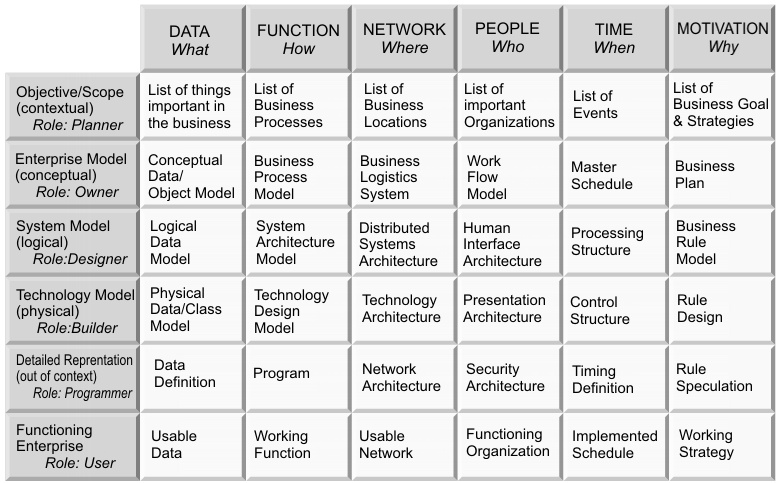
Zachman Framework. Source: Marcel Douwe Dekker based on earlier work of Phogg2 et al.
The Zachman Framework categorizes architectural artifacts into six perspectives or viewpoints, each representing a different stakeholder's view on the enterprise. These perspectives are:
- Planner's Perspective: Defines the scope, goals, and objectives of the enterprise.
- Owner's Perspective: Specifies the entities and relationships that comprise the enterprise.
- Designer's Perspective: Details the processes, functions, and data flows within the enterprise.
- Builder's Perspective: Describes the technology infrastructure and platforms used to implement the enterprise.
- Subcontractor's Perspective: Specifies the physical components and configurations of the enterprise.
- Functioning Enterprise Perspective: Represents the operational aspects and real-world behavior of the enterprise.
Within each perspective, the Zachman Framework defines six abstraction levels to increase granularity. These abstraction levels are:
- Scope: Defines the overall context and boundaries of the enterprise.
- Business Model: Describes the structure and behavior of the enterprise from a business perspective.
- System Model: Specifies the logical structure and processes of the enterprise.
- Technology Model: Details the technology infrastructure and platforms supporting the enterprise.
- Component Model: Represents the physical components and configurations of the enterprise.
- Instance Model: Provides specific examples or instances of the enterprise in operation.
Each cell in the Zachman Framework corresponds to a specific perspective (e.g., Planner's, Owner's, Designer's) and abstraction level (e.g., Scope, Business Model, System Model). Together, they provide a comprehensive, structured framework for analyzing, documenting, and managing architectures from multiple viewpoints and levels of detail.
ArchiMate
ArchiMate was initially developed in the early 2000s by a team of researchers led by Prof. Dr. Jaap Schekkerman, who recognized the need for a standardized language for enterprise architecture modeling.
ArchiMate defines a set of symbols and notation for representing architectural concepts, relationships, and viewpoints. These symbols include elements such as business processes, actors, applications, data objects, and technology components. The notation is based on a graphical language, making it easy to create visual models and diagrams that communicate complex architectural concepts effectively.
ArchiMate is designed to be compatible with other enterprise architecture frameworks and methodologies, such as TOGAF and Zachman Framework. Architects use ArchiMate tools to create, edit, and share ArchiMate models collaboratively.
Solution architect training and certification
As mentioned, a solution architect orchestrates solution-level decisions, aligning them with overall business objectives, providing technical guidance, monitoring development progress, and keeping stakeholders informed.
Skillset and background
Here are some areas of expertise a solution architect needs.
Technical expertise. Several years of experience in IT areas such as software architecture, infrastructure, cloud development, software design, business analysis, DevOps, and project management.
Communication skills. Crucial for negotiating with stakeholders, understanding needs, managing risks, and explaining complex concepts to various parties.
Analytical abilities. Ability to understand business processes, corporate strategy, and technical specifics to design effective solutions.
Project management skills. While not directly managing projects, a solution architect must ensure alignment with deadlines, resources, and long-term goals, guiding the development process accordingly.
Solution architect certifications
Solution architect certifications validate expertise in specific skills. Platforms like AWS, Azure, and Google Cloud offer certifications at associate and professional levels.
AWS Certified Solutions Architect exams cost $150 to $300 and cover domains like infrastructure, security, and data platforms. Certifications are valid for 3 years, requiring recertification thereafter.
Microsoft's Azure Solutions Architect Expert certification assesses skills in designing Azure solutions. The exam costs $165 and focuses on tasks like infrastructure implementation and security design.
ITIL certifications, including the ITIL Master and the ITL Expert, validate expertise in IT service management. Candidates must demonstrate practical application of ITIL principles.
Google Cloud's Professional Cloud Architect certification assesses skills in designing and managing cloud solutions. The exam costs $200 and requires recertification every two years.
If you want a more comprehensive overview of the role, head out to read our article about a solution architect.
When to employ solution architecture
Although the process of solution architecture is extremely valuable in the context of introducing new technology, it doesn’t mean that every project needs a solution architect. But here are a few scenarios that would definitely benefit from a structural expert approach.
When you’re facing integration challenges. When integrating new software systems or technologies into existing infrastructure, solution architecture will ensure seamless compatibility and alignment with business goals.
When you’re undertaking digital transformation. Companies undergoing digital transformation initiatives require solution architecture to align technology solutions with evolving business needs and objectives.
When you’re managing complex projects. Projects with multiple technology risks, uncertain requirements, or the need for integration across various systems benefit from the strategic guidance of solution architecture.
When you’re presenting product roadmaps. When pitching product roadmaps to investors or stakeholders, solution architecture provides insights into the technological solutions that best align with business objectives.
When you need to facilitate stakeholder communication. Solution architecture bridges the communication gap between technical and nontechnical stakeholders, ensuring all requirements are understood and addressed effectively.

